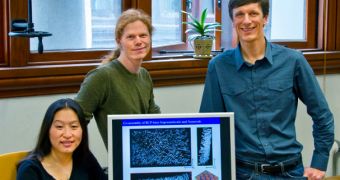US Department of Energy (DOE) Lawrence Berkeley National Laboratory (Berkeley Lab) experts announce the development of a technique that induces nanoscale crystal rods to self-assemble into uni-, bi-, and three-dimensional structures at the macroscopic scale.
The achievement is extremely important, especially considering that the technique operates very fast, is easy to apply, and costs almost nothing. Crystal nanorods boast a wide array of potential applications in numerous fields of science.
One particular use where these tiny structures are bound to excel in the future are magnetic storage devices, such as for example hard drives. At the same time, they could be used to improve the efficiency of solar cells and other types of sensors.
In addition to their uses in various equipment and devices, crystal nanorods are also an important component of nanorod-polymer composites, says project leader and polymer scientist Ting Xu.
He holds joint appointments at the Berkeley Lab Materials Science Division and the University of California in Berkeley (UCB) Departments of Materials Sciences and Engineering, and Chemistry.
“Ours is a simple and versatile technique for controlling the orientation of nanorods within block copolymers,” Xu explains. She adds that copolymers are long sequences of a single type of monomer, which are bound to sequences of another monomer.
“By varying the morphology of the block copolymers and the chemical nature of the nanorods, we can provide the controlled self-assembly in nanorods and nanorod-based nanocomposites that is critical for their use in the fabrication of optical and electronic devices,” the team leader explains.
Details of the research effort appear in a paper entitled “Direct Nanorod Assembly Using Block Copolymer-Based Supramolecules,” which appears in the latest issue of the journal Nano Letters.
The next step in this research is to investigate how nanoparticle self-assembly may become possible within various shape combinations. The DOE Office of Science has already expressed interest in supporting the new investigation as well.
“For the study of three-dimensional nanorod assemblies, we needed to implement high-resolution tomography and this posed a challenge not only for collecting the imaging data but also for processing it,” Xu concludes.

 14 DAY TRIAL //
14 DAY TRIAL //